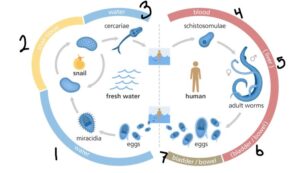SCHISTOSOMIASIS: PART 2
Welcome Back!
Today we will be learning how unsafe water practices contribute to further infection and are the leading cause in the continued spread of this acute chronic disease throughout communities…
The life cycle (reference the image below)
The life cycle begins when worm eggs mature in a water source into their larval form known as miracidia (1). Then, freshwater snails in the water take in the larval form (2). The snails provide a safe place for the larva to grow and mature into their next form. The snails excrete the next larval form known as the cercariae into the water (3). From there, the cercariae can easily penetrate the skin of humans in the water source and enter the blood stream as a larval form within tissue known as a schistosomulae (4). Once in the blood stream, the larva matures into the mature adult worms, which then go on to penetrate various tissues and organs, most commonly the liver, bladder, and bowel (5). Once worms have made their way to the bowels and bladder (their final destination in the body), they lay their eggs (6). The eggs are then excreted in urine and feces into a water source and the cycle begins again (7). The life cycle is important in explaining how the issue of schistosomiasis stays prevalent in these communities. Without safe water practices, the parasitic worms are able to continue to infect people and continue to spread through communities.

Symptoms of Schistosomiasis
Schistosomiasis is an acute and chronic disease caused by parasitic worms known as flukes. The infection begins in contaminated water sources, where larval forms of the parasitic worm are released. When wading, drinking, or bathing, the worms penetrate the skin on contact. Once in the blood stream, there are a few fates for the worms. The first is continuation of the life cycle, where the adult worm lays eggs which are then excreted through urine or feces. The second fate is when the worms become trapped with in different body tissues, which leads to more long-term complications. The most common symptoms of schistosomiasis include abdominal pain, diarrhea, and blood in the stool or urine. Liver enlargement is also associated with the disease, which can damage the liver and important processes the liver must do to keep the body functioning. Depending on the organ the worms migrate to, the damage can be different. Schistosomiasis causes more disability than death, but there is still a large number of deaths each year due to the disease.
How can Schistosomiasis be treated?
Schistosomiasis does not go away on its own and can last up to 3 months if not treated. It must be treated with medication or prevented all together with safe water practices. The medication is easily accessible here in the United States, but in sub-Saharan Africa, it is a completely different story. The drug Praziquantel requires a prescription and can cost upwards of 600 dollars for the dose needed stop the infection. This drug is out of the question for small communities in Africa, therefore, those who contract it, suffer the conditions of the disease. In areas like this, the best was to treat the disease is to prevent the infection in the first place. The infection doesn’t only come from drinking contaminated water, but also comes from exposure of the skin to contaminated water. To prevent schistosomiasis, large-scale treatment to at-risk areas must be done to ensure safe, clean water sources. Prevention methods include keeping drinking water separate from water sources used for bathing and other sanitation purposes.
What are the key aspects to contamination control?
Water to Thrive’s mission is to provide clean water to these people to ensure they are not paralyzed with these diseases. A key aspect of the work that Water to Thrive does is building clean water well, but the most important part is teaching the community about how to maintain the wells and keep their water clean. Education about maintaining clean water is vital to prevent these kinds of diseases from devastating communities. Although access to clean water is just the first of many steps towards basic sanitation, it allows these communities to have a necessary foundation to gain access to sanitation and improve the health of the individuals in the community. The support we have from our numerous donors not only allows us to fund the building of wells, but also improve the livelihoods of so many people in these communities.
Be sure to join us next week for some more highly informative, real world talk about waterborne illness and disease, the first step to real change is awareness!
-Jesseca Hemminger
Sources:
https://www.who.int/news-room/fact-sheets/detail/schistosomiasis
https://www.cdc.gov/parasites/schistosomiasis/index.html